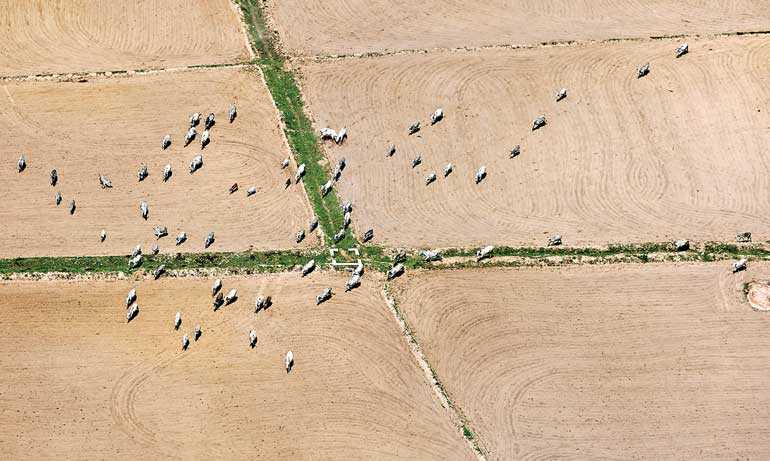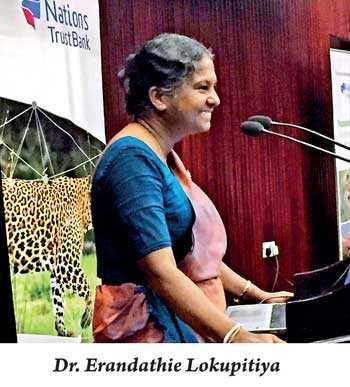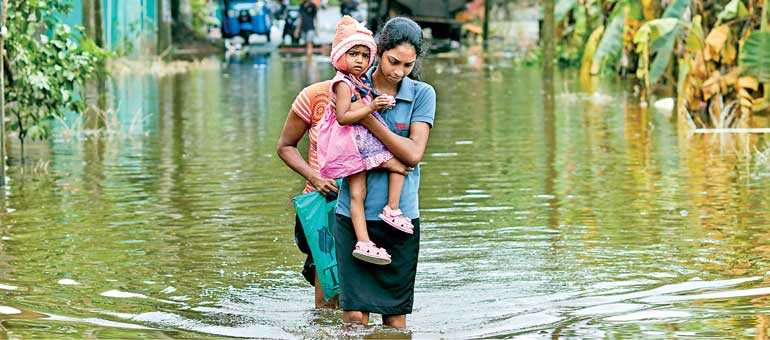Monday Mar 17, 2025
Monday Mar 17, 2025
Saturday, 22 June 2019 00:10 - - {{hitsCtrl.values.hits}}

When it comes to tackling a problem, it’s always easier to address one that is visible and tangible. With global warming, it’s the gradual nature of the beast that sneaks up on people, despite numerous warnings – Pic by Devaka Seneviratne
 By Madushka Balasuriya
By Madushka Balasuriya
As a writer, one of the most critical aspects in compiling a story is differentiating between the information in your head and what’s needed in the story. A general rule of thumb is that you should invariably have more information than what you’re putting down on paper.
In that sense, when Dr. Erandathie Lokupitiya began her address at the monthly Wildlife and Nature Protection Society (WNPS) lecture titled ‘Climate Change and our Responsibility,’ my mind wandered to the wealth of information she wasn’t telling her audience. And the thought terrified me.
The lecture itself was supremely comprehensive – almost to a fault; it began with quite literally a definition of the word climate, something a child in grade 3 would be able to tell you. To many in the audience, this might have seemed like overkill, but then again if you’re a scientist specialising in the impact of climate change on the world around you, and you live in a world where your life›s work is constantly brought into question by those with but a fraction of the information you have, wouldn’t you too err on the side of caution and start right at the beginning? Just so there are no misunderstandings? Because this is, if nothing else, a matter of life and death.
No that’s not hyperbole, here’s some context: Earlier this week India’s sixth largest city, Chennai, ran out of water; in 2017, the South African city of Cape Town had to take drastic measures to stave off a water shortage; in 2015, Sao Paolo in Brazil ran out of water; in Sri Lanka, in the Northern and Eastern Provinces, people are struggling to find drinking water following a prolonged drought, while at the same time other parts of the island have been overwhelmed by floods; and this does not even begin to touch on the record cold, snow, and flooding in the American mid-west, nor the heat waves killing thousands on the streets of India and Pakistan. The list really does go on and on.
Now, if an extra-terrestrial life form were to come to down to Earth tomorrow and offer their assistance in bettering our planet, I imagine the logical starting point would be to rectify the root cause of such problems, which is of course the gradual heating of our planet. However, in what is a scarcely believable yet undeniably the most human of quirks, several individuals in positions of power, with the means at hand to effect meaningful change, seem to either completely disbelieve or simply choose to ignore the problem. The irony of going against their self-interest in pursuit of their self-interest is also seemingly lost on all involved.
Though that is, admittedly, a simplification of how matters stand. The truth of the matter is, there is a surfeit of misinformation that has been passed along, now readily available on the internet, something that has been perpetuated by the fact that most of it is doused with a sprinkling of truth.
The myth of natural climate variances
One of the most common misconceptions is based around the notion that the present anomalies in the Earth’s climate are a natural periodic occurrence, a sequence of events which can be dated back through time over a series of ice ages and subsequent global warming. However, as Dr. Lokupitiya gently explains, while natural climate variance is indeed based in science, the anticipated period for which the Earth should have cooled has long since passed.
“Based on the natural variability of the Earth’s climate, we have been experiencing alternating cold and warm periods on Earth. Ice ages and non-ice ages, or glacial and inter-glacial periods,” she began.
“Right now we’re in a warm period with our last ice age ending about 10,000 years ago. So, when we consider the natural climate variability towards the 1960s, people were experiencing a cooler climate and were anticipating that we would be heading towards a cooler climate on Earth. But towards the end of the 1980s they realised it was not the case.”
It was this realisation, brought on by a wave of research into climate variance and its relationship with greenhouse gas emissions, that led to the first studies being published on humanity’s impact on the global climate in the late ’80s.
Things eventually came to a head in 1992, when several of the world’s leading nations came together at the Earth Summit in Brazil and signed the United Nations Framework Convention on Climate Change (UNFCCC), a treaty that aimed to “stabilise greenhouse gas concentrations in the atmosphere at a level that would prevent dangerous anthropogenic interference with the climate system”.
Enhanced Greenhouse Effect
Over the last few decades the term “Greenhouse Effect” has taken on understandably negative connotations, widely considered as the main contributor to global warming. However placing the blame squarely on greenhouse gases would be the equivalent of blaming cars for all car crashes.
The fact of the matter is, the greenhouse effect is a completely natural process that warms the Earth’s surface, without which our planet would be an inhabitable frozen dead zone. The problem however arises from the entirely manmade “Enhanced Greenhouse Effect”, according to Dr. Lokupitiya.
“Nowadays we blame them for causing global warming but they’re very important when it comes to our habitability and keeping Earth at a temperature that life can exist. If these gases weren’t there in the atmosphere the temperature of our planet would have been freezing cold.
“But sadly what we have done through our activities, is that we have increased the concentration of these gases big time. About 80% of global warming is down to fossil fuel emissions, which has mostly come from the burning of fossil fuels since the start of the Industrial Revolution in the mid-18th century, and also due to deforestation.”
Two of the major contributors to this enhanced greenhouse effect are the energy and waste management sectors, especially in Sri Lanka. Last month Cabinet approved three new coal power plants, which is in line with forecasts that predict Sri Lanka’s power generation plan will see a doubling of the percentage share of coal energy by 2034, representing a five-fold increase in the use of coal by Ceylon Electricity Board (CEB). The argument put forward by the CEB is that as Sri Lanka has low emissions in comparison to the rest of world, they can ‘afford’ to use coal power. Dr. Lokupitiya however counters that this is no longer a country by country issue and that we all have to do our part if we’re to even begin mitigating the worst consequences of climate change.
“In the past China and India told the developed countries: ‘you’ll had a chance to develop now it’s our turn, but you won’t let us because you say our emissions are too high.’ We’re a small country and our emissions are relatively low, but the problem is that it doesn’t matter how big an emitter you are because once the emissions are in the atmosphere there are no boundaries.”
When it comes to waste management, Sri Lanka’s failings in this regard are rarely far from the news. The most recent was the Meethotamulla landslide in 2017, when mountain of garbage collapsed on a low-income housing development killing 32 people.
When you take into consideration the amount of methane released by large garbage landfills, landslides will be the least of our concerns.
“If you don’t properly dispose of your waste all of it goes and ends up in some landfill site. There it releases methane, which has a high global warming potential compared to carbon dioxide (Co2). About 300 times the global warming potential.”
Climate inequality
In terms of the arguments made by developing nations in Asia and smaller nations such as Sri Lanka, there is a legitimate sense of injustice at play with regard to these climate change-related consequences. How fair is it to suffer for the indiscretions of others? This is something Dr. Lokupitiya acknowledges, though her plea remains unchanged.
“When you consider global Co2 emissions, the richest 10% on Earth emit 49% of the greenhouse gases, whereas the poorest 50% emit only 10%. It’s unfair. “And to make matters worse it’s the poorest that suffer the most from climate change. But the problem is when something is released to atmosphere it will circulate globally and the impact will fall on everybody.”
Indeed, in Sri Lanka alone in the last few years, higher temperatures and more variable precipitation has led to both an increase in floods as well as droughts, with the resultant extreme events adversely impacting agriculture and water resources. In the future, agriculture will also be affected by sea level rises, as impacts on coastal infrastructure would see salt water intrusions, which would in turn affect local communities and area water quality.
Deforestation is also a major concern in the country, as heavier precipitation would mean a rise in soil erosion, leading to the siltation of reservoirs and marked increase in landslides (something Sri Lanka is already quite familiar with).
Meanwhile ocean acidification would take a grievous toll on marine life and coral reefs which, along with warmer temperatures and increased frequency in extreme weather events, would cause severe damage to Sri Lanka’s biodiversity and ecosystems.
And these are not the far-off doomsday scenarios they once were, they’re taking place now.
Our responsibility
When it comes to tackling a problem, it’s always easier to address one that is visible and tangible. With global warming, it’s the gradual nature of the beast that sneaks up on people – despite numerous warnings.
As far as governmental action goes, following the initial the UNFCCC treaty, there have been subsequent extensions such as the Kyoto Protocol in 1997 and the Paris Agreement signed in 2016. Be that as it may, there have nevertheless been setbacks, most notably the Trump presidency which has seen the US pull out of an agreement that just years prior they were one of the foremost advocates of. As highlighted earlier, that will undoubtedly have a domino effect on the global climate, where it will be the poor that suffer the most.
This in itself is an extension of that curious facet of climate change that allows us to fairly easily ignore the problem right in front of us. This is not surprising in the slightest though, as humans are adaptable if not anything else. But as Dr. Lokupitiya points out, the signs are there if you look for it.
“In the past when it used to rain, it would start with a drizzle and we would like to feel the drizzle. And when we knew that it was drizzle we would look to find some shelter before the big rain came, but now if it’s starts drizzling, do you have time to run to shelter? No, it won’t give us even a minute sometimes, it would pour down as torrential rain. And even in five minutes of rain you’ll see a massive amount of rainfall. This rainfall intensity increase is a direct result of global warming, and we know that when it continues, that’s when it results in floods.”
Add to this the regular rise in temperatures, and the impacts of global warming clearly don’t need to hit extreme levels for it to be felt on a day to day basis.
For Dr. Lokupitiya any meaningful change will require the involvement of the Government, not just in long-term sustainable policy making such as the encouragement of green industries and reforestation, but more practical measures such as improved public transport systems, the encouraging of bicycle usage and the strict implementation of bike lanes, and the consistent implementation of regulation and awareness to reduce the use of single-use plastics.
However, she explains, this does not absolve the citizens of a country from their responsibilities.
“Single-use plastics are a serious climate change hazard, that’s something we can easily avoid. Obviously plastics can’t be got rid of completely, but if you reduce even a little it can have a big impact.”

A thought
Now if you’re wondering if this was all Dr. Lokupitiya divulged in her lecture, you’d be quite mistaken. There were snippets about the possibility of the Arctic Permafrost melting and plunging the planet irreversibly beyond the global temperature tipping point of 2 degrees Celsius, there were anecdotes of her time in the US and their ambivalence to climate change, there was an entire section on how wildlife is being tragically impacted by changes in global temperatures, and there was the expected bemoaning of government inaction, among other things.
Of course for the purpose of this article I distilled the lecture into the bits I felt were pertinent, in the hope of best encapsulating the spirit of the content – which is what gave me moment for pause, because I realised that is also what Dr. Lokupitiya did.
And even though she offered up her views in as endearing a way as possible, the simple thought of her having even more pressing evidence of the impending chaos unchecked climate change could wreak was simply…terrifying.
Discover Kapruka, the leading online shopping platform in Sri Lanka, where you can conveniently send Gifts and Flowers to your loved ones for any event including Valentine ’s Day. Explore a wide range of popular Shopping Categories on Kapruka, including Toys, Groceries, Electronics, Birthday Cakes, Fruits, Chocolates, Flower Bouquets, Clothing, Watches, Lingerie, Gift Sets and Jewellery. Also if you’re interested in selling with Kapruka, Partner Central by Kapruka is the best solution to start with. Moreover, through Kapruka Global Shop, you can also enjoy the convenience of purchasing products from renowned platforms like Amazon and eBay and have them delivered to Sri Lanka.
Discover Kapruka, the leading online shopping platform in Sri Lanka, where you can conveniently send Gifts and Flowers to your loved ones for any event including Valentine ’s Day. Explore a wide range of popular Shopping Categories on Kapruka, including Toys, Groceries, Electronics, Birthday Cakes, Fruits, Chocolates, Flower Bouquets, Clothing, Watches, Lingerie, Gift Sets and Jewellery. Also if you’re interested in selling with Kapruka, Partner Central by Kapruka is the best solution to start with. Moreover, through Kapruka Global Shop, you can also enjoy the convenience of purchasing products from renowned platforms like Amazon and eBay and have them delivered to Sri Lanka.